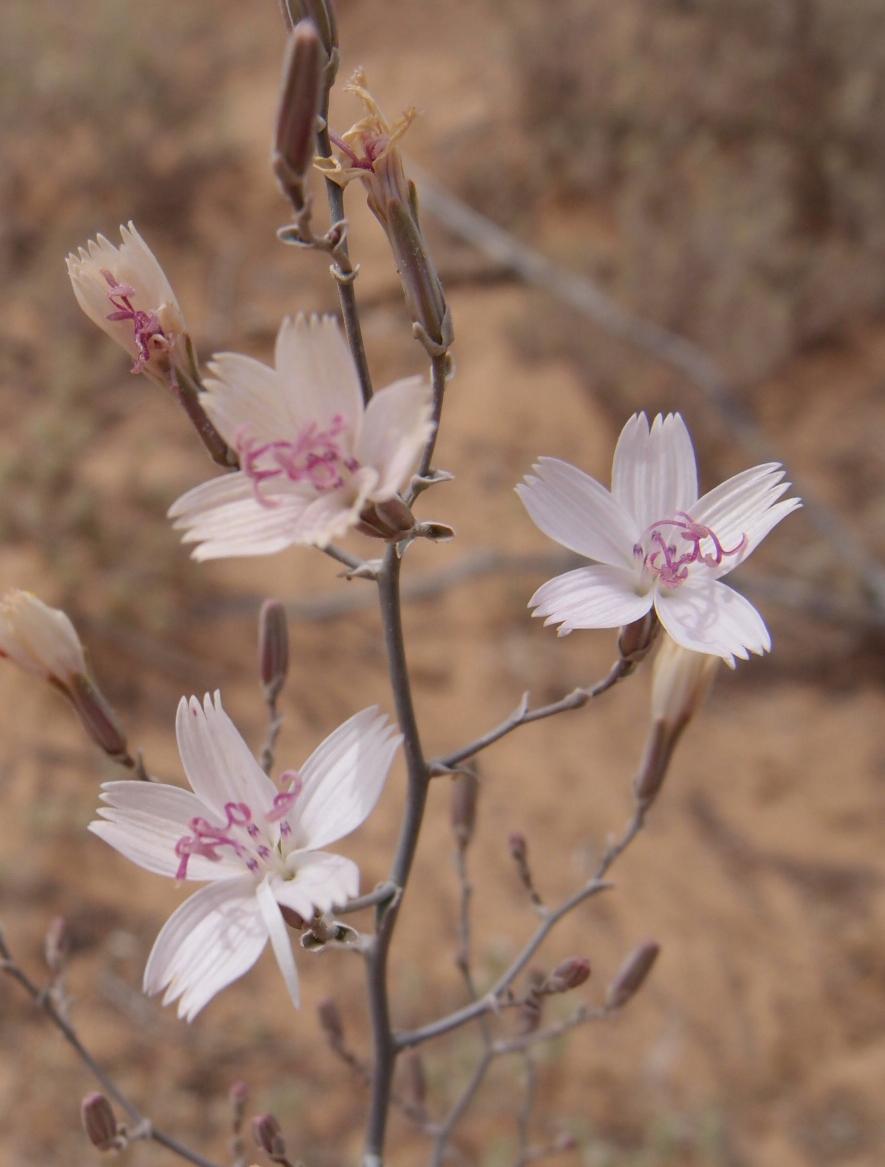
|
Family: Asteraceae |
Annuals, 10-200 cm, taprooted, or perennials, 10-100 cm. with deeply seated, woody caudices or stout or slender, creeping rhizomes. Stems (1-8) erect, simple or branched, usually glabrous, sometimes hairy (especially when young). Leaves basal (withered at flowering in annuals and some perennials) and/or cauline (much reduced, bractlike in annuals and some perennials); usually sessile; blades linear to oblong, oblanceolate, or spatulate, usually runcinate, margins usually pinnately lobed (spinulose-tipped in S. parryi), sometimes entire or toothed (S. lactucina, S. tenuifolia, and S. fluminea (faces glabrous, puberulent, or tomentose); distal bractlike (to 45 mm in S. fluminea). Heads borne singly or clustered (in paniculiform arrays in some subspecies of S. exigua). Peduncles not inflated distally, sometimes bracteate. Calyculi of 3-5, unequal bractlets (more numerous in some perennials; not distinguishable in S. cichoriacea), appressed or reflexed (some annuals). Involucres ± cylindric to turbinate, 2-3(-5+) mm diam. Phyllaries usually 5-12 in 1 series, equal (20-25 in 2-3 series, unequal in S. cichoriacea, usually glabrous, rarely puberulent, densely stipitate-glandular in S. exigua subsp. deanei). Receptacles flat, usually smooth (pitted in S. cichoriacea), glabrous, epaleate. Florets (4-)5-16; corollas usually pink or lavender, sometimes white (annuals often purple-tinged abaxially). Cypselae light tan to dark brown, columnar, sometimes slightly curved, 5-angled, apices truncate, faces equal, sometimes with ribs between faces, each face with central, narrow, longitudinal groove or furrow (not grooved in S. virgata), otherwise smooth or bumpy to tuberculate, usually glabrous (scaberulous in S. fluminea); pappi persistent (or only widened bases of bristles persistent after distal portions break off) or falling, of 5-40, distinct or basally connate in groups, white to tan, wholly or distally plumose bristles in 1 series. x = 8. Because all the species of Stephanomeria have not previously been examined at one time, the present treatment provides the first unified picture of their variability, ecologic specializations, and geographic distributions. The genus includes six annual species (all in the flora) and ten perennial species (eight in the flora, one in the mountains of northern Baja California, and one known only from Guadalupe Island, Mexico). Taxonomic distinctions among annual species of Stephanomeria did not become evident until their morphology and geographic distributions were correlated with their chromosome numbers and reproductive compatibilities (L. D. Gottlieb 1971, 1972). The same studies also provided an hypothesis that satisfactorily accounted for their variability. Studies showed that S. exigua and S. virgata differed for a relatively large number of characters and that other annual species originated from genetic segregates that were formed by hybridization, at both diploid and tetraploid levels, as well as directly from S. exigua. Stephanomeria exigua has five subspecies; S. virgata has two. Within each species, the subspecies share numerous morphologic features as well as chromosomal karyotype. They are recognized as polytypic because reproductive compatibility between any pair of subspecies of S. exigua or between subspecies of S. virgata is substantially higher than is the compatibility between the two species. The two species appear to represent a fundamental phylogenetic divergence within annuals; nevertheless their different features are combined in different ways in S. elata and S. diegensis. Stephanomeria paniculata and S. malheurensis probably evolved more or less directly from S. exigua subsp. coronaria. The speciation process that gave rise to S. malheurensis (L. D. Gottlieb 1978) has been examined in a series of studies (Gottlieb 1973b, 1977, 1979; S. Brauner and Gottlieb 1987, 1989). The origin of the highly self-pollinating S. paniculata may have been similar but much less evidence is available. Stephanomeria malheurensis has served as a model for reintroduction of a species back into its original habitat after local extinction, in its case by competition from invasive cheatgrass (Bromus tectorum). Information about evolution and speciation is not so available for the perennials as for the annuals. Treatment of perennials is based almost entirely on examination of herbarium specimens plus published information describing their chromosome numbers. Although little is known about phylogenetic relationships among perennial species of Stephanomeria, a recent DNA sequencing study of nuclear rDNA (J. Lee et al. 2002) showed that the genus does not include either Munzothamnus blairii (previously S. blairii) or Pleiacanthus spinosus (previously S. spinosa). Without them, Stephanomeria is a well-supported, monophyletic group of species. The DNA analysis suggested that Stephanomeria tenuifolia, S. runcinata, S. fluminea, and S. thurberi comprise a subclade. Those four species are perennial and all have fully plumose, white pappus bristles. They differ markedly in their ecologic specializations, as indicated in their treatments below. The DNA studies also showed a very close relationship between S. malheurensis and S. exigua subsp. coronaria consistent with results of previous studies (ci |



